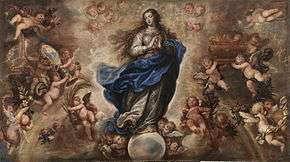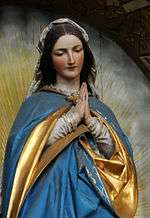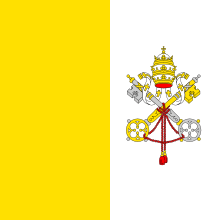Feast of the Immaculate Conception
The Solemnity of the Immaculate Conception celebrates the belief in the Immaculate Conception of the Virgin Mary. It is universally celebrated on December 8, nine months before the feast of the Nativity of Mary, which is celebrated on September 8. The Immaculate Conception is one of the most important Marian feasts in the liturgical calendar of the Roman Catholic Church, and is celebrated worldwide.
| Solemnity of the Immaculate Conception | |
|---|---|
 Mary's holy and immaculate conception, by Francisco Rizi, Museo del Prado, 17th-century, Oil on canvas. | |
| Observed by | Roman Catholic Church |
| Significance | Belief in the most pure and sinless conception of the Blessed Virgin Mary without Original Sin |
| Celebrations | Festive pageantry, grand fireworks, cultural dancing, religious and military processions, ethnic food and costumes |
| Observances | Mass and other liturgical celebrations |
| Date | December 8 |
| Next time | 8 December 2020 |
| Frequency | annual |
| Related to | Nativity of Mary Assumption of Mary |
By Pontifical designation and decree, it is the patronal feast day of Argentina, Brazil, Korea, Nicaragua, Paraguay, Philippines, Spain, the United States, Uruguay and Italy. By royal decree, it is also designated as the Patroness of Portugal. It is celebrated by the Roman Catholic Church as well as a few other closely related Protestant Christian churches, but not by the Eastern Orthodox Church, the Oriental Orthodox Church, and Church of the East.
Since 1953, the pope in his capacity as Bishop of Rome visits the Column of the Immaculate Conception in Piazza di Spagna to offer expiatory prayers commemorating the solemn event.
The feast was first solemnized as a Holy Day of Obligation[1] on 6 December 1708 under the Papal Bull Commissi Nobis Divinitus[2][3] by Pope Clement XI[4] and is often celebrated with Mass, parades, fireworks, processions, ethnic foods, and cultural festivities in honor of the Blessed Virgin Mary and is generally considered a Family Day, especially in many majority-Catholic countries.
History
| Part of a series on the |
| Mariology of the Catholic Church |
|---|
 Virgo by Josef Moroder-Lusenberg |
|
|
|
|
|
|
The Eastern Christian Church first celebrated a "Feast of the Conception of the Most Holy and All Pure Mother of God" on December 9, perhaps as early as the 5th century in Syria. The original title of the feast focused more specifically on Saint Anne, being termed sylepsis tes hagias kai theoprometoros Annas" ("conception of Saint Anne, the Ancestress of God").[5] By the 7th century, the feast was already widely known in the East. However, when the Eastern Church called Mary achrantos ("spotless" or "immaculate"), this was not defined doctrine.
The majority of Orthodox Christians do not accept the Scholastic definition of Mary's preservation from original sin before her birth as subsequently defined in the Western Church after the Great Schism of 1054.[6] After the feast was translated to the Western Church in the 8th century, it began to be celebrated on December 8. It spread from the Byzantine area of Southern Italy to Normandy during the period of Norman dominance over southern Italy. From there it spread to England, France, Germany, and eventually Rome.[7]
In 1568, Pope Pius V revised the Roman Breviary, and though the Franciscans were allowed to retain the Office and Mass written by Bernardine dei Busti, this office was suppressed for the rest of the Church, and the office of the Nativity of the Blessed Virgin was substituted instead, the word "Conception" being substituted for "Nativity."[8]
According to the Papal Bull Commissi Nobis Divinitus, dated 6 December 1708, Pope Clement XI mandated the feast as a Holy Day of Obligation which is to be celebrated in future years by the faithful.[9] Furthermore, the pontiff requested that the papal bull be notarized in the Holy See to be further copied and reproduced for dissemination.
Prior to Pope Pius IX's definition of the Immaculate Conception as a Roman Catholic dogma in 1854, most missals referred to it as the Feast of the Conception of the Blessed Virgin Mary. The festal texts of this period focused more on the action of her conception than on the theological question of her preservation from original sin. A missal published in England in 1806 indicates the same Collect for the feast of the Nativity of the Blessed Virgin Mary was used for this feast as well.[10]
The first move towards describing Mary's conception as "immaculate" came in the 11th century. In the 15th century, Pope Sixtus IV, while promoting the festival, explicitly tolerated both the views of those who promoted it as the Immaculate Conception and those who challenged such a description, a position later endorsed by the Council of Trent.[5]
The proper for the feast of the Conception of the Blessed Virgin Mary in the Medieval Sarum Missal merely addresses the fact of her conception.
The collect for the feast reads:
O God, mercifully hear the supplication of thy servants who are assembled together on the Conception of the Virgin Mother of God, may at her intercession be delivered by Thee from dangers which beset us.[11]
In 1854, Pius IX issued the Apostolic constitution Ineffabilis Deus: "The most Blessed Virgin Mary, in the first instant of her conception, by a singular grace and privilege granted by almighty God, in view of the merits of Jesus Christ, the saviour of the human race, was preserved free from all stain of original sin."[12] This marked no actual change in doctrine, but rather marked the first instance of formal definition of the dogma.
According to the Universal Norms on the Liturgical Year and the Calendar, 5, when the solemnity of the Immaculate Conception, which always occurs within Advent, falls on a Sunday, it is transferred to the following Monday.[13] (In some countries, including the United States, the obligation to attend Mass does not transfer.)[14] The 1960 Code of Rubrics, still observed by some in accordance with Summorum Pontificum, gives the feast of the Immaculate Conception preference even over an Advent Sunday.[15]
Cultural influence

The solemnity is an official public holiday in the following sovereign countries and territories:

























- In Nicaragua, the solemnity is celebrated with local parades and religious processions.
- In Panama, it is considered Mother's day
- In Spain, since 1760, the day is marked as a national holiday as designated by Pope Clement XIII.
- In Italy, it is a national holiday while since 1953, the Pope in his capacity as Bishop of Rome visits the Column of the Immaculate Conception in Piazza di Spagna to offer expiatory prayers commemorating the solemn event. The day marks the official start of the Christmas season in the country.
- In the Philippines, the day is designated as a non-working Public holiday in honor of the Virgin Mary as Patroness of the country and was permanently signed into constitutional law as holiday on 29 March 2017 by the Philippine government.
Blue liturgical vestments

The Holy See, through the Sacred Congregation of Rites grants the express privilege to use blue or cerulean vestments on this day for the Spanish crown and its former territories. Numerous pontiffs have expressed the same sentiment via a Pontifical decree, namely the following:
- Pope Pius VII granted the express privilege to permit blue vestments to the Archdiocese of Seville on 28 November 1819.
- Pope Pius IX granted to the Primate of Spain on 8 December 1854 within the Archdiocese of Toledo. The same privilege of allowing blue vestments for Cuba on 5 May 1862. Ultimately, he clarified the privilege extended to all Spanish colonies on a decree dated 12 February 1864.
- Pope Leo XIII accorded the privilege of blue vestments for Peru on a papal document dated 25 September 1891. The Catholic leadership in Chile also makes the same claim to this privilege.
- Pope Pius X reiterated this sentiment for both former and present territories of Spain via a pontifical decree on 7 September 1903. The same Pontiff issued a papal bull retaining the privilege for the Philippines to use blue vestments on 11 February 1910. The bull was signed and executed by Cardinal Rafael Merry del Val.[19]
Several petitions were submitted to the Holy See to use blue or violet vestments for other Marian feasts of the Blessed Virgin Mary, which is considered an ecclesiastical abuse by the Sacred Congregation of Rites, and ruled against it on 23 February 1839.
Anglican Communion
In the Church of England, the "Conception of the Blessed Virgin Mary" may be observed as a Lesser Festival on 8 December. The situation in other constituent churches of the Anglican Communion is similar, i.e., as a lesser commemoration.[20] Many Anglo-Catholic parishes observe the feast using the traditional Roman Catholic title, the "Immaculate Conception of the Blessed Virgin Mary".
Eastern Orthodoxy
While the Eastern Orthodox Churches have never accepted the Roman Catholic dogma of the Immaculate Conception, they do celebrate December 9 as the Feast of the Conception by St. Anne of the Most Holy Theotokos. While the Orthodox believe that the Virgin Mary was, from her conception, filled with every grace of the Holy Spirit, in view of her calling as the Mother of God, they do not teach that she was conceived without original sin as their understanding and terminology of the doctrine of original sin differs from the Roman Catholic articulation.[21] The Orthodox do, however, affirm that Mary is "all-holy" and never committed a personal sin during her lifetime.[22]
The Orthodox feast is not a perfect nine months before the feast of the Nativity of the Theotokos (September 8) as it is in the West, but a day later. This feast is not ranked among the Great Feasts of the church year, but is a lesser-ranking feast (Polyeleos).
See also
- Gottfried von Hagenau, author of the epic poem Liber sex festorum beatae Virginis (1293−1300)
- Patronages of the Immaculate Conception
Notes
- Clementis XI, Papam - CXX - Mandatur ut Festum Conceptionis beatae Mariae Virginis Immaculatae de praecepto ubique observetur - Commissi Nobis Divinitus sacrosancti apostolatus officii exigit ratio, ut gloriossimae Virginis Dei genitricis Mariae cuius Conceptio gaudium annuciavit universo mundo, venerationem et cultum, plurium Romanorum Pontificum praedecessorum nostrorum more, ampliare studentes in terris, illius, quae super choros angelorum exaltata pro populo Christiano sedula exoratrix apud eum, quem genuit, assidue intercedit in caelis, potentissimam opem in toltantisque, quibus premimur, Christianae reipublicae et Catholicae Ecclesiae necessitatibus, quantum nobis ex alto conceditur, promereri iugiter satagamus. Datum Romae, apud Sanctum Petrum, sub annulo Piscatoris, die 6 Decembris 1708 Pontificatus Nostri Anno IX. - http://www.icar.beniculturali.it/biblio/pdf/bolTau/tomo_21/02_T21_189_368.pdf (PP. 338)
- Lacoste, Jean-Yves (29 September 2004). Encyclopedia of Christian Theology. ISBN 9780203319017.
- "Introduction". Archived from the original on 2012-02-18.
- De Maria Numquam Satis: The Significance of the Catholic Doctrines on the Blessed Virgin Mary for All People, Judith Marie Gentle, Robert L. Fastiggi eds., University Press of America, 2009 ISBN 9780761848479
- "CATHOLIC ENCYCLOPEDIA: Immaculate Conception".
- Timothy Ware (Bishop Kallistos). The Orthodox Church (London: Penguin Books, 1963), pp. 263-264.
- Francis X. Weiser. Handbook of Christian Feasts and Customs (New York: Harcourt, Brace & World, 1958), p. 292.
- Habig O.F.M., Marion A. "Land of Mary Immaculate", The American Ecclesiastical Review, June 1954
- Commissi Nobis Divinitus - VI Decembris 1708 - Clementis XI, Papam - Sincera itaque nostra erga eamdem augustissimam caeli reginam, patronam, advocatam, nostram, devotione incitati festum conceptionis ipsius beatae mariae virginis immaculatae ubique terrarum in posterum ab omnibus et singulis utriusque sexus christifidelibus sicut alia festa de praecepto observationis festorum comprehendi auctoritate apostolica, tenore praesentium decernimus praecipimus et mandamus. ...Volumus autem ut earumdem praesentium literrarum transumptis, seu exemplis etiam impressis, manu alicuius notarii publici subscriptis, et sigillo personae in ecclesiastica dignitate constitutae munitis, eadem prorsus fides adhibeatur ipsis praesentibus si forent exhibitae vel ostensae.
- The Roman Missal in English Tr. John England (Philadelphia: Eugene Chummiskey, 1843), p. 529.
- The Sarum Missal in English Tr. A. Harford Pearson (London: The Church Printing Co., 1834), p. 332.
- Ineffabilis Deus the Apostolic Constitution of Pope Pius IX on the Immaculate Conception (December 8, 1854), in the Acta Pii IX, pars 1, Vol. 1, p. 615.
- Universal Norms on the Liturgical Year and the Calendar
- Edward McNamara, "Feast of the Immaculate Conception", ZENIT, 17 December 2013.
- Code of Rubrics, 15
- "Executive Order 60/2000" (in Portuguese) – via Imprensa Oficial.
- "Republic Act No. 10966" – via Official Gazette.
- "Earth Calendar".
- https://www.youtube.com/watch?v=kSNNdG4ekfY
- "Archived copy". Archived from the original on 2013-11-04. Retrieved 2013-11-03.CS1 maint: archived copy as title (link)
- Timothy Ware, The Orthodox Church (Penguin Books, 1963, ISBN 0-14-020592-6), pp. 263-4.
- "The Sinlessness of the Theotokos". Monastery of St. Tikhon of Zadonsk. Archived from the original on 2020-07-12. Retrieved 2020-07-12.
External links
- Conception of the Theotokos Article about the Orthodox feast from Orthodoxwiki.org

